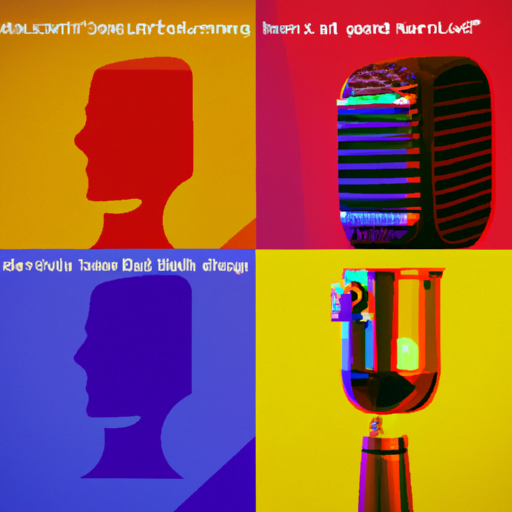
-
Table of Contents
The Impact of Voice User Interfaces on Graphic Design

In recent years, voice user interfaces (VUIs) have gained significant popularity and have become an integral part of our daily lives. From virtual assistants like Siri and Alexa to voice-controlled smart home devices, VUIs have revolutionized the way we interact with technology. As VUIs continue to evolve and become more sophisticated, they are also having a profound impact on the field of graphic design. In this article, we will explore the various ways in which VUIs are shaping the future of graphic design and discuss the implications for designers.
1. Redefining User Experience
VUIs are fundamentally changing the way users interact with technology by providing a more natural and intuitive interface. Instead of relying on traditional graphical user interfaces (GUIs), which require users to navigate through menus and click on buttons, VUIs allow users to interact with devices using their voice. This shift in interaction paradigm has significant implications for graphic designers.
With VUIs, designers need to consider how to create a seamless and engaging user experience without relying on visual cues. They must focus on designing voice interactions that are clear, concise, and easy to understand. This requires a deep understanding of user behavior, language patterns, and the context in which the VUI will be used.
For example, when designing a voice-controlled smart home device, the designer needs to consider how users will interact with the device in different scenarios. They need to anticipate and design for various user inputs, such as voice commands, questions, and even errors. This requires a careful balance between providing enough guidance and feedback to the user without overwhelming them with unnecessary information.
2. Simplifying Information Design
One of the challenges of graphic design is presenting complex information in a visually appealing and easy-to-understand manner. VUIs offer an opportunity to simplify information design by presenting information through spoken language instead of visual elements.
For example, imagine a weather app that provides a visual representation of the weather forecast, including temperature, humidity, and precipitation. With a VUI, the designer can present this information through spoken language, eliminating the need for complex visualizations. The user can simply ask, “What’s the weather like today?” and the VUI will provide a concise and relevant response.
This shift towards voice-based information design requires designers to think differently about how they present information. They need to focus on creating clear and concise spoken responses that convey the necessary information without overwhelming the user. This often involves simplifying complex concepts and using plain language that is easily understood by a wide range of users.
3. Enhancing Brand Identity
VUIs provide a unique opportunity for brands to enhance their identity and create a more personalized user experience. By designing a distinct voice and personality for their VUI, brands can establish a stronger connection with their users.
For example, the virtual assistant Siri is known for its friendly and helpful personality, while the virtual assistant Alexa has a more neutral and professional tone. These distinct personalities help to differentiate the brands and create a memorable user experience.
Designers play a crucial role in shaping the voice and personality of a VUI. They need to consider factors such as tone, language style, and even the use of humor. This requires a deep understanding of the brand’s values, target audience, and the context in which the VUI will be used.
4. Adapting to Multimodal Interfaces
While VUIs primarily rely on voice interactions, they are increasingly being integrated with other forms of input and output, such as touchscreens and displays. This trend towards multimodal interfaces presents new challenges and opportunities for graphic designers.
Designers need to consider how to create a seamless and consistent user experience across different modalities. They need to ensure that the visual elements, such as icons and buttons, are designed in a way that complements the voice interactions. This often involves creating visual cues that provide additional context and feedback to the user.
For example, when designing a voice-controlled car dashboard, the designer needs to consider how to display relevant information on the screen while still prioritizing voice interactions. They may use visual elements, such as color-coded icons or progress bars, to provide visual feedback and enhance the user experience.
5. Embracing Accessibility
VUIs have the potential to greatly enhance accessibility for individuals with disabilities. By providing a voice-based interface, VUIs can enable individuals with visual impairments or motor disabilities to interact with technology more easily.
Designers have a responsibility to ensure that VUIs are accessible to all users. This includes considering factors such as speech recognition accuracy, language clarity, and the ability to customize the VUI to meet individual needs. Designers can also leverage other accessibility features, such as closed captions or haptic feedback, to enhance the user experience.
Conclusion
Voice user interfaces are transforming the field of graphic design by redefining user experience, simplifying information design, enhancing brand identity, adapting to multimodal interfaces, and embracing accessibility. As VUIs continue to evolve and become more prevalent, designers need to adapt their skills and approaches to meet the unique challenges and opportunities presented by this emerging technology.
By understanding the impact of VUIs on graphic design and staying abreast of the latest trends and best practices, designers can position themselves at the forefront of this exciting and rapidly evolving field. The future of graphic design is undoubtedly intertwined with the rise of voice user interfaces, and designers who embrace this shift will be well-positioned to create innovative and engaging experiences for users.
